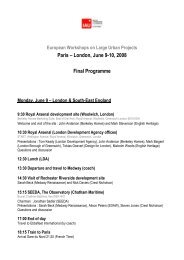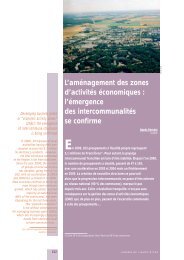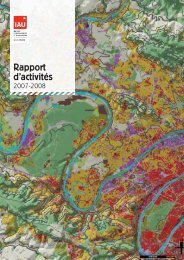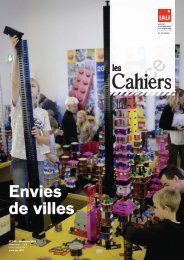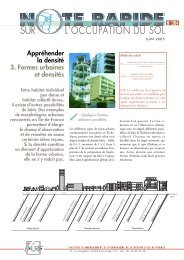Plaine Saint-Denis and Paris North East projects
Plaine Saint-Denis and Paris North East projects
Plaine Saint-Denis and Paris North East projects
Create successful ePaper yourself
Turn your PDF publications into a flip-book with our unique Google optimized e-Paper software.
<strong>Plaine</strong> <strong>Saint</strong>-<strong>Denis</strong> <strong>and</strong> <strong>Paris</strong> <strong>North</strong> <strong>East</strong> <strong>projects</strong>Developments areas <strong>and</strong> playersPaul LecroartSenior Urban PlannerUrban <strong>and</strong> Regional Planning Agency for the <strong>Paris</strong> Ile-de-France Region(Institut d'Aménagement et d'Urbanisme de la Région d'Ile-de-France)European Workshops on Large Urban Projects / <strong>Paris</strong> – London, June 9-10, 2008
IntroductionThe aims of the <strong>Paris</strong>-London workshops is to exchange practice in urban development <strong>and</strong>regeneration schemes & processes.The Workshop works has selected four main questions to inform <strong>and</strong> discuss:• Who decides <strong>and</strong> carries out the project?• Who pays for what?• How is the project designed, planned <strong>and</strong> implemented?• What are the outcomes?The development schemes studied are:• Large <strong>and</strong> difficult former industrial sites which need an important public impulse <strong>and</strong>investment before being marketable.• Complex mix-use redevelopment <strong>projects</strong>, involving several actors from the public<strong>and</strong> private sectors.• Part of a larger regeneration strategy for a wider (metropolitan) area: ThamesGateway <strong>and</strong> <strong>Plaine</strong> de FranceTwo sub-regional development areas frame this workshop.• <strong>Plaine</strong> <strong>Saint</strong> <strong>Denis</strong> / <strong>Paris</strong> <strong>North</strong>-<strong>East</strong> (<strong>Paris</strong> <strong>and</strong> Ile-de-France region)Both areas are part of larger regional <strong>and</strong> sub-regional strategies covered by specificschemes <strong>and</strong> instruments: <strong>Plaine</strong> de France, a major development area supported bycentral government, the Region, two Departements <strong>and</strong> 40 municipalities, <strong>and</strong> theGr<strong>and</strong> Projet de Renouvellement Urbain (GPRU) de la couronne de <strong>Paris</strong>, the social<strong>and</strong> physical renewal of the <strong>Paris</strong> City rim.• Thames Gateway (London <strong>and</strong> the South <strong>East</strong> of Engl<strong>and</strong>)A major regional regeneration project supported by central government <strong>and</strong> itsagencies, three regions <strong>and</strong> 17 districts; additional partnerships have been createdwithin the Gateway.Within these large areas, case studies have been selected for the French side of Workshop.<strong>Plaine</strong> <strong>Saint</strong>-<strong>Denis</strong> regeneration areaWithin this 750-hectare area of former declining industries <strong>and</strong> transport infrastructure,located immediately to the north of <strong>Paris</strong>, <strong>and</strong> being regenerated since the end of the 1980s(see notes in this pack), we will be focusing on two areas.L<strong>and</strong>y France development areaThe L<strong>and</strong>y France development area, created in 1996, a 26 hectare, 270,000 sq m of mixuseoffice-led development. This first ‘post-World Cup’ urban is a tabula-rasa-typedevelopment with large office blocks (the former gas works were dismantled in the 1970s)branched on a new RER station, under the leadership of the SEM <strong>Plaine</strong> CommuneDéveloppement.Montjoie development areaThe Montjoie area is a 21 hectare development with a 181,000 sq m of industry, housing <strong>and</strong>educational facilities objective. It is an early project developed with ups <strong>and</strong> downs since1988 which shows the evolutions in the overall concept of the <strong>Plaine</strong> <strong>Saint</strong>-<strong>Denis</strong>regeneration. It is developed by a public developer controlled by the Department of Seine<strong>Saint</strong>-<strong>Denis</strong> (‘county’).European Workshops on Large Urban Projects / <strong>Paris</strong> – London, June 9-10, 2008
Ongoing urban development <strong>and</strong> <strong>projects</strong> in part of the <strong>Plaine</strong> <strong>and</strong> <strong>Paris</strong> <strong>North</strong> <strong>East</strong><strong>Plaine</strong> Commune (2007)European Workshops on Large Urban Projects / <strong>Paris</strong> – London, June 9-10, 2008
South of the <strong>Plaine</strong> <strong>Saint</strong>-<strong>Denis</strong>, other public <strong>and</strong> private-led <strong>projects</strong> he Icade-EMGP<strong>projects</strong> -such as Canal-Porte d’Aubervilliers- will also be looked into to see how publicauthorities (<strong>Plaine</strong> Commune, City of <strong>Paris</strong>), public developers (SEM <strong>Plaine</strong> CommuneDéveloppement, SEMAVIP, etc.) <strong>and</strong> a private l<strong>and</strong>-owner <strong>and</strong> developer -now a real estateinvestor- can invent into different kinds of public-private partnerships to allow newdevelopment.<strong>Paris</strong> Nord-Est urban redevelopment projectThis 200-hectare <strong>and</strong> 1,1 million sq m building programme is an ambitious mix-useredevelopment project launched in the year 2002 whose objective is to host 25,000 morejobs <strong>and</strong> 10,000 new residents. It is made up of fragmented areas on both sides of the <strong>Paris</strong>Peripherique. The future development is backed by plans for new transport facilities (RERstation, tramway). François Leclercq is the coordinating architect-planner of the whole areafor the City of <strong>Paris</strong>.The Workshop will focus on two single developments.Claude Bernard development projectThe Claude Bernard ‘sustainable’ development project. This 15 hectares project launched in2005 will develop before 2012, 103,000 sq m of offices, housing <strong>and</strong> leisure functions, onboth sides of the Périphérique Boulevard (<strong>Paris</strong> inner ring motorway). The developer is theSEMAVIP, a City of <strong>Paris</strong>-controled public developer.The MacDonald warehouse reconversionThe MacDonald warehouse is a new type of public-private partnership (SAS <strong>Paris</strong>-Nord-Est)has been set by three stakeholders (CDC-bank, Icade Foncier Développement <strong>and</strong>SEMAVIP) for the reconversion of the building. The program is over 160,000 sq. m ofhousing, offices, business, retail, <strong>and</strong> facilities. The designer of the project is OMA (RemKoolhaas) <strong>and</strong> the new building is expected to be delivered in 2012;2. The regeneration of the <strong>Plaine</strong> <strong>Saint</strong>-<strong>Denis</strong> : some key players<strong>Plaine</strong> RenaissanceCreated in 1985, <strong>Plaine</strong> Renaissance (Syndicat mixte <strong>Plaine</strong> Renaissance) was the first jointformal local initiative for the regeneration of the <strong>Plaine</strong> <strong>Saint</strong>-<strong>Denis</strong> industrial area. Gatheringfirst-h<strong>and</strong> knowledge <strong>and</strong> expertise on the assets <strong>and</strong> drawbacks of the <strong>Plaine</strong>, <strong>Plaine</strong>Renaissance managed to convince public <strong>and</strong> private stakeholders to invest in a social,environmental <strong>and</strong> economical project for the future of the area. The organisation preparedthe Inter-municipal Development Charter (1990-1991) <strong>and</strong> the Urban Project process (1991-1998), <strong>and</strong> worked as an local development agency until the creation of <strong>Plaine</strong> Commune in1999.Hippodamos 93The urban designers of the 1991 consultation, architects Yves Lion, Pierre Riboulet, Reichen& Robert, <strong>and</strong> l<strong>and</strong>scape architect Michel Corajoud, got together to conduct the UrbanProject planning <strong>and</strong> design studies <strong>and</strong> created to this end the GIE Hippodamos 93(‘Economic Interest Group’). In 1992, they produced the Urban Project, a vision <strong>and</strong> amethod for regeneration. In 1993-1994, among other works, they studied the integration ofthe Stade de France <strong>and</strong> related infrastructure into Project. With the creation of the UrbanPlanning Departement of <strong>Plaine</strong> Commune in the years 1999-2001, the activity ofHippodamos has ceased.European Workshops on Large Urban Projects / <strong>Paris</strong> – London, June 9-10, 2008
Early regeneration partners• Cities of <strong>Saint</strong>-<strong>Denis</strong> <strong>and</strong> Aubervilliers: initiators of regeneration in the <strong>Plaine</strong> <strong>Saint</strong>-<strong>Denis</strong>, in charge of planning <strong>and</strong> overall development impulse & control until 2000when <strong>Plaine</strong> Commune was created.• City of <strong>Paris</strong> : L<strong>and</strong> owner of Stadium area <strong>and</strong> of Canal <strong>Saint</strong>-<strong>Denis</strong>• Local State Administration (Direction Régionale de l’Equipement) : World Cup project<strong>and</strong> transport coordination, Strategic area committee co-leader. Overall developmentcontrol <strong>and</strong> Regional Structure Plan.• Ile-de-France Regional Council : Infrastructure <strong>and</strong> urban development funding. Nowin charge of Regional Structure Plan with the State (DREIF).• Consortium Stade de France : Private a 30-year concessionary company of theStadium in charge of financing part of the facility <strong>and</strong> operating the facility.• EMGP, now Icade EMGP: private developer <strong>and</strong> investor of about 70 hectares southof the <strong>Plaine</strong> <strong>Saint</strong>-<strong>Denis</strong> including the Parc des Portes de <strong>Paris</strong>, business park.• Other large ‘private’ l<strong>and</strong> owners in the <strong>Plaine</strong> <strong>Saint</strong>-<strong>Denis</strong> playing a part indevelopment: Electricité de France, Gaz de France, <strong>Saint</strong>-Gobain.<strong>Plaine</strong> Commune DéveloppementCreated in 1991 to implement the Urban Project for the <strong>Plaine</strong> <strong>Saint</strong>-<strong>Denis</strong>, <strong>Plaine</strong> CommuneDéveloppement is a joint public urban development company (société d’économie mixte orSEM) between local authorities (Aubervilliers & <strong>Saint</strong>-<strong>Denis</strong> at first, now <strong>Plaine</strong> Commune)with a minority participation of central government. It has merged after the World Cup withthe State-led development agency set up to conduct the Stadium facility development <strong>and</strong>the Stadium quarter : the SANEM Stade de France. It currently conducts developments suchL<strong>and</strong>y-France or Nozal-Chaudron (Diderot Quarter). It also contributes to partnership<strong>projects</strong> such as Porte d’Aubervilliers-Canal with Icade <strong>and</strong> studies such as the ProudhonGardinoux development.<strong>Plaine</strong> CommuneThis inter-municipal association is an ‘urban community’ uniting 8 municipalities of thenorthern suburbs of <strong>Paris</strong> around a common development project. <strong>Plaine</strong> Commune has a 42sq km-large territory with 330,000 inhabitants, 135,000 jobs, <strong>and</strong> 47,000 students. It has itsown ‘Urban Community Council’ its own tax ressources <strong>and</strong> budget. It has delegated powersfrom the municipalities such as planning <strong>and</strong> development, environment, housing <strong>and</strong> socialpolicies, <strong>and</strong> tourism policy.EPA <strong>Plaine</strong> de FranceSince its creation in 2000, the Etablissement Public d’Aménagement de la <strong>Plaine</strong> de Franceis in charge of strategic urban planning <strong>and</strong> physical development, for the economical <strong>and</strong>social regeneration of the area. The EPA’s is a joint development agency with a board ofdirectors made up of representatives of the State, the Ile-de-France Regional Council, thetwo départements of Seine-<strong>Saint</strong>-<strong>Denis</strong> <strong>and</strong> Val-d’Oise, <strong>and</strong> 40 municipalities (<strong>and</strong> their intermunicipalassociations). Its task is to conduct studies, coordinate <strong>projects</strong>, provide technical<strong>and</strong> financial assistance to the local authorities, <strong>and</strong> develop directly larger, complex orstrategic sites.Some urban development instruments• Stade de France Agreement (1993): State – <strong>Saint</strong>-<strong>Denis</strong> City – <strong>Paris</strong> City :infrastructure & improvements related to the World Cup• State – Regional Council Contrats de Plan (CPER in French, i.e. Regional 5-yearInvestment Programmes 1994-1998 & 2000-2006), <strong>and</strong> Contrat de Projet 2007-13.• Development areas (Zones d’aménagement concerté or ZAC) of public initiative.Currently development is going through about a dozen ZAC in the <strong>Plaine</strong>.European Workshops on Large Urban Projects / <strong>Paris</strong> – London, June 9-10, 2008



